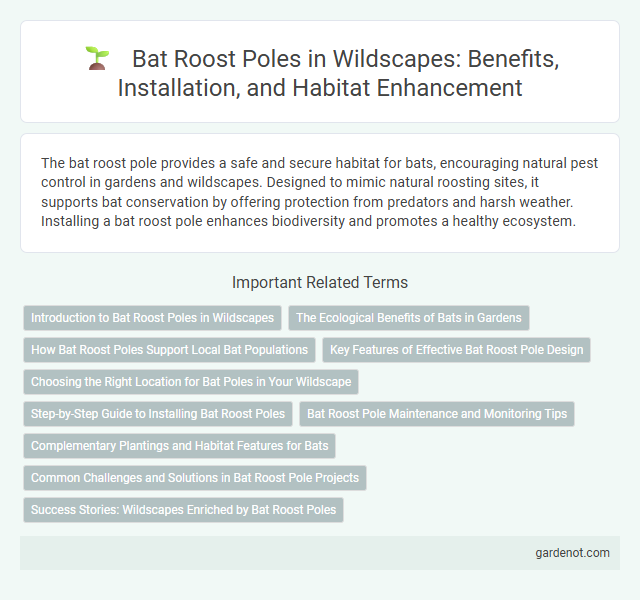The bat roost pole provides a safe and secure habitat for bats, encouraging natural pest control in gardens and wildscapes. Designed to mimic natural roosting sites, it supports bat conservation by offering protection from predators and harsh weather. Installing a bat roost pole enhances biodiversity and promotes a healthy ecosystem.
Introduction to Bat Roost Poles in Wildscapes
Bat roost poles provide essential habitats for nocturnal bats by mimicking natural tree cavities, promoting biodiversity within wildscapes. These vertical structures are designed with rough surfaces and crevices to offer safe shelter and breeding sites, supporting local bat populations. Installing bat roost poles enhances ecosystem balance by encouraging insect control and pollination activities.
The Ecological Benefits of Bats in Gardens
Bat roost poles provide essential habitats for bats, supporting their role as natural pest controllers by significantly reducing garden insect populations. These structures enhance biodiversity by promoting healthy bat colonies, which contribute to pollination and seed dispersal within garden ecosystems. Installing bat roost poles fosters ecological balance and boosts the overall health of garden environments.
How Bat Roost Poles Support Local Bat Populations
Bat roost poles provide essential habitats by offering safe, elevated resting sites that mimic natural tree cavities, supporting local bat populations by enhancing shelter availability. These structures promote biodiversity by facilitating breeding and roosting activities, crucial for bats' survival and reproduction. Strategically placed bat roost poles help maintain ecological balance by encouraging insect population control through natural predation.
Key Features of Effective Bat Roost Pole Design
Effective bat roost pole design incorporates a textured wooden surface to provide secure climbing grips and crevices for bat attachment. The poles should be installed at a minimum height of 3 meters to ensure safety from predators and human disturbances. Proper orientation towards sheltered, shaded areas enhances temperature regulation and promotes prolonged bat habitation.
Choosing the Right Location for Bat Poles in Your Wildscape
Selecting the optimal location for a bat roost pole in your wildscape involves identifying quiet, sheltered areas with minimal human disturbance and nearby water sources to support bat foraging. Position the pole at least 12 feet high in a spot that receives morning sunlight and afternoon shade to regulate temperature and encourage bat occupancy. Ensure the surrounding vegetation provides natural flight corridors to enhance accessibility and safety for roosting bats.
Step-by-Step Guide to Installing Bat Roost Poles
Install a bat roost pole by selecting a sturdy, untreated wooden pole at least 4 meters tall to ensure safe access for bats. Secure the pole deeply into the ground, ideally 60-90 cm, using concrete or firm soil to prevent tipping, then attach rough wooden panels or bat boxes to provide roosting surfaces. Place the pole in a sunny, open area away from artificial lighting and near water or woodland habitats to optimize bat activity and support local biodiversity.
Bat Roost Pole Maintenance and Monitoring Tips
Regular inspection of bat roost poles ensures structural integrity and optimal habitat conditions, preventing decay and damage from weather exposure. Cleaning around the base helps reduce predator access and maintains a safe environment for bats. Monitoring bat activity through daytime checks and occasional bat detectors provides valuable data on population health and roost usage patterns.
Complementary Plantings and Habitat Features for Bats
Complementary plantings around bat roost poles include native shrubs such as hawthorn and elderberry, which provide essential foraging habitats and cover for bats. Incorporating wildflower meadows nearby supports insect populations, enhancing food availability for nocturnal feeding activities. Habitat features like nearby water sources and undisturbed tree lines create optimal conditions for bat navigation and shelter within wildscape environments.
Common Challenges and Solutions in Bat Roost Pole Projects
Bat roost pole projects often face challenges such as selecting appropriate locations that balance human activity and bat habitat needs, ensuring structural stability against weather conditions, and preventing predation or disturbance. Solutions include using durable, weather-resistant materials like treated wood or composites, installing poles at sufficient heights and proximity to natural foraging areas, and incorporating predator guards or mesh barriers to protect roosting bats. Regular monitoring and community engagement enhance the success and adaptive management of bat roost pole installations.
Success Stories: Wildscapes Enriched by Bat Roost Poles
Bat roost poles installed in various Wildscapes have significantly increased local bat populations by providing safe, sheltered habitats essential for breeding and hibernation. These structures enhance biodiversity by supporting insect control and pollination, contributing to healthier ecosystems. Numerous success stories highlight improved bat activity and species diversity directly linked to strategically placed roost poles in diverse habitats.
Bat roost pole Infographic

 gardenot.com
gardenot.com